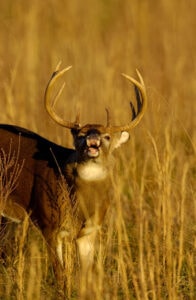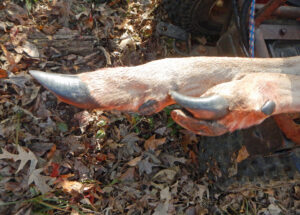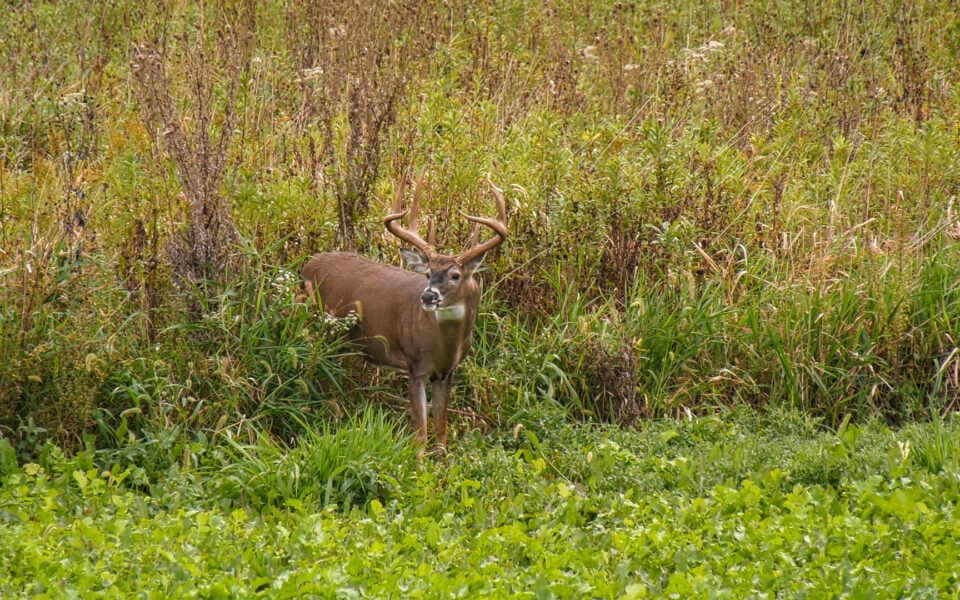I will dare to say that no large mammal has been more scrutinized in the past 70 years than the white-tailed deer. It is believably the favorite big game animal in North America, with magazines, television and books educating hunters as to the best means of putting venison in the freezer and antlers on the wall.
White-Tailed Deer Sub-Species

Tes Jolly
There are 38 recognized subspecies of white-tailed deer when you include the subspecies of Central and South America. In the US and Canada there are 17 sub-species with a few stark differences between them. The diminutive 75-pound Key deer of Florida is a stark contrast to the Kansas subspecies that can grow to over 300 pounds.
The big problem with these subspecies classifications is that when they were determined, they were based on physical features rather than genetic distinctions. When you consider all the variation in nutrition across the range of the white-tail, it’s no surprise that scientists way back when thought they were subspecies.
As some states imported deer during the 1930s, 40s and 50s in an effort to reestablish populations, numerous sub-species were inadvertently mixed. In Mississippi for example, deer from Virginia, Wisconsin, Texas and Mexico were introduced.
Predominate sub-species include the “Texas” which has distinctively wide antlers. The southeastern sub-species include a wide variety of differences. Deer feeding for their lifetime on browse in the rich alluvial floodplain of the Mississippi River become the stuff of legends, while their hill country cousins just a few miles away may grow the same number of points at the same age, will just never have the comparable mass. It is this writer’s belief that nothing short of DNA indexing and analysis will define sub-species accurately.
Just as there are differences in subspecies, there are many things that are the same with all of them. Just as all mammals, deer have the senses of touch, sight, smell, taste and hearing. In a world where survival dictates fight or flight, the deer is an expert at taking flight. A whitetail’s sense of smell is said to be 10,000-times greater than that of a human. It has been determined they have the ability to sort six different scents out of a mix. It may seem like a stretch, but I can just see a wise old buck sniffing a mineral lick and thinking “there’s sea salt, Himalayan pink salt, some manganese, and a dab of cotton seed meal holding it together…..”.
Their eyesight is extremely keen, especially to movement. Deer notice changes in their environment, when something is out of place, they tend to be suspicious. Their rod and cone structure is such that they see well at any hour of the day. Deer in essence see two colors. This is called dichromatic vision. They see short blue and middle green wavelengths well. They are least sensitive of the long wavelengths such as red and orange. They may see other colors, but their brains are not wired to separate those hues.
The Whitetail Rut
There is no set day when the pre-rut begins, and it can vary widely north to south. There is rutting going on somewhere in their range from as early as August through February. Most believe the photoperiod (the interval in a 24-hour period during which a plant or animal is exposed to light) is the main trigger, but there are more variables that impact timing.
“Does are starting to wean fawns, which if the does conceived during the peak of the rut and the fawns were born after a normal gestation period, on average during mid-July should be about four months old,” Dr. Bronson Strickland of Mississippi State University’s Deer Research Facility said. “Photo period, a strong influence in the rut, is growing shorter. Deer coat colors are starting to change from reddish to brown. Does still feeding young are trying to store fat reserves for the winter to replenish fat lost to lactation.”
During this same time bucks are undergoing a change of their own. Antlers are hardening, causing velvet to itch, and bucks may rub the shedding velvet onto trees. But this is only one small reason a buck will rub. We’ll get to that a bit later.
At the same time the infertile buck will realize an increase in testosterone, his testicles will again hang, where they had been recessed. Buck groups will start sparing among themselves in a prelude to fighting for dominance coming in the near future. Factually speaking, a buck is ready to breed very soon after these changes.
Does Control the Rut
“It is the doe that experiences the hormonal changes that actually trigger the breeding period commonly known as the rut,” Strickland said. The doe is influenced by photo period (the amount of daylight), genetics also play a factor, and health a factor. If a doe is not healthy enough to enter estrus she may ovulate again 28 days later. This can happen several times, or she may not enter estrus at all, if not healthy enough to breed and carry fawns. Photo period is relative, but not the only factor. December 21, give or take a few hours is the shortest photo period in the northern hemisphere, so we’ll see how that relates to the kickoff of the rut.”
Many bait-shop biologists feel cold weather is needed to spark the rut, but there is no scientific evidence to sustain that claim. The only connection is incidental. Moon phase might be a factor, but again no evidence exists that the moon effects the rut other than deer are more active on moonlight nights.
According to Dr. Strickland, a rut will take place every year. Buck–to-doe ratio can play a part, human pressure such as hunting can play a part, and warmer weather can play a part, but a rut will occur.
Knowing the rut’s dynamics will give the hunter the tools to possibly harvest a buck of a lifetime. Assuming a hunter reads the wind correctly, remains as scent-free as possible, and is willing to devote the time to the endeavor, chances are better than average in their favor.
White-Tailed Deer Digestive System
The digestive system of white-tailed deer is uniquely capable of processing a wide variety of forage. Deer are browsers rather than grazers, although they may appear to graze in a food plot or agricultural field. An adult deer requires a minimum of seven dry weight pounds of forage per day to exist. That forage may consist of forbs, soft and hard mast, and tree buds.
Since many foods are seasonal, the deer’s diet is adapted to these seasonal changes. Apples, persimmons, grapes and orchard fruits are popular in season. Acorns are probably the deer’s favorite hard mast. Available during fall and as long as they last into the winter, acorns can provide much of the needed protein deer need to build fat reserves that will carry them through the winter until the spring green-up.
When asked “what is a whitetail’s best defense mechanism against predators?” few would answer “their stomach,” but it’s true. Their four-chambered stomach allows them to consume food very quickly in feeding areas where they are vulnerable to predation, and then bed down and chew and digest it later.
Professor Snape, of Harry Potter fame, didn’t supply complete information when he taught his students that a “bezoar” is a “stone taken from the stomach of a goat.” You can find them, though rare, in the stomachs of whitetails and other animals, too.
What is a bezoar? It’s basically a pearl for mammals. An indigestible object gets hung up in the digestive tract, and over time it becomes coated with multiple layers of minerals, forming a smooth stone, also known as a “mad stone.” This works out well for the animal because the smooth object is now less of an irritant to the stomach lining.
How common are bezoars in deer? That’s unknown, and since very few of us root and sift through the stomach contents of the deer we harvest, it’s likely we’ll never know. Most of those that are formed are probably never discovered for this reason. However, you can certainly learn a lot about a deer’s diet this way, and who knows? You might just find your own bezoar.
Antler Development in White-Tailed Deer
A buck deer begins growing antlers almost at birth. As most of you know, buck fawns have little bumps on their heads called pedicles from which antlers will grow, be cast off and regrow annually as the buck matures. These pedicles give rise to the term “button-buck.”

Tes Jolly
Antlers are made of bone and are covered with a blood rich covering called velvet, for as long as they are growing. When nature starts triggering a rise in testosterone the velvet begins to die and itch. The buck then rubs the velvet from his antlers, perhaps in as little as a single day. In the winter, following rutting activity, the testosterone level drops, existing antlers fall off, and new antler growth begins.
As the new set of antlers grow, a buck’s diet is supplying life sustaining nutrition for a growing body, and some is used to grow antlers. As a buck ages, less nutrition is needed for skeletal and body growth so then more can then be diverted to antler development. Thus, as deer age, the larger their antlers grow until they get to around age 5 or 6 years old. If all environmental factors are equal, at this age a buck should have the best set of antlers he is likely to ever have.
We asked Dr. Bronson Strickland, of the Mississippi State University Deer Lab, about antler growth. This was his reply, “Regarding antler growth, well, it’s both. It’s true a lot of the minerals are mobilized from bones, but also diet too. And where did the minerals in the bones come from? From his diet, of course. The theory is that antler development occurs so rapidly that deer have to mobilize minerals from their bones, and then will replenish those minerals via diet over time.”
Those gamekeepers who wish to hunt the biggest bucks obviously need to allow younger bucks to advance in age, and plant and manage their land so that it provides the best nutrition possible.
White-Tailed Deer Glands
Deer have been leaving messages for other deer for as long as deer have existed. One of the ways they do this is with gland secretions and receptors. Rubs and scrapes are often referred to as “signposts” where deer leave messages to the other deer in the area. Every hunter should understand how deer use these locations to improve their chances of bagging a trophy.
When a buck makes a rub, he is leaving scent from his periorbital glands. Other deer smell this and identify the maker (or user) of the rub with their magnificent olfactory system. Bucks also urinate down their back legs onto their hocks so that the scent of their tarsal gland is allowed to pool in a scrape, again advertising his presence to other deer.
A lesser publicized gland that comes into play is the interdigital gland, located between their two “toes” (digitals). Interestingly, as bucks get older and thus larger, the scent form this gland gets stronger. This allows other deer to take a whiff of the track and determine the approximate age of the buck who made it.
Finally, there is the vomeronasal organ, also known as the “Jacobson’s organ” which bucks use to literally taste the pheromones of an estrus doe. The organ is located in the roof of the mouth and this action is known as the “Flehmen response,” or “lip curl.”
Once the doe and the buck make the connections and she stands to be bred, don’t think for a minute she is true to her man. While the buck may need time to recover, the doe will move on to the next stud and stand for him too. Tests from DNA have concluded that twin fawns from the same mother, dropped at the same time, can have different sires. This raises an interesting question about whether bucks from two sub-species could impregnate the same doe and produce fawns.
Common Diseases and Maladies

Tes Jolly
Chronic Wasting Disease (CWD) has been at the forefront of all those concerned with whitetail health. There has been much information disseminated about this fatal disease. Some based in fact and some based in what I like to call “bait-shop” biology. I asked two award-winning deer biologists to read the following paragraphs before submitting them to my editor. I want this information to be the kind a gamekeeper can take to the bank.
CWD is the result of a deer ingesting a mutant protein known as a prion. It is not a bacteria or a virus. A prion is a mutant cell that occurs inside an infected deer then is expelled through mucus or saliva. Although it is not known for certain, it is thought that these prions can be picked up through deer-to-deer contact or by one deer eating where an infected deer has also eaten.
Currently there are few controls for CWD other than aggressive herd management – meaning killing off the herd. But it isn’t known…are we killing deer that may have a natural immunity? The fewer deer living on a given plot of ground, the less likely the chance of CWD transmission between animals. The life of a prion in the wild is believed to be very long, possibly infinite. Most areas where CWD has been found are placed in CWD management zones. Within these zones the transportation of harvested deer and parts are restricted and testing is required. Luckily, there is no known instance of CWD being transferred from deer to humans.

David Hawkins
Epizootic Hemorrhagic Disease (EHD) also known as “Blue Tongue” is a widespread deer illness caused by a tiny insect called a midge. These tiny gnat-like creatures live in the mud around water holes and their bits infect the deer when they come to water. Unlike CWD, the midges disappear when freezing weather comes and deer that have been infected can and do survive. However, the disease can be fatal as well. Those deer that recover develop immunity to the illness and a doe that develops immunity passes that on to her off-spring.
Typical signs of EHD include hoof sloughing, where the outer coating of the toes breaks or actually falls off. Swelling of the mouth parts and breathing problems are also symptoms. Dead or dying deer with EHD are often found in or near water. It is believed a fever that accompanies the ailment causes this behavior. The meat of an EHD deer is safe for human consumption when properly cooked.
Warts’ growing on the face, neck and other parts of the body is a condition that is unsightly but apparently not fatal to deer. Known as viral fibromas, these warts generally do not cause health problems unless they interfere with vision or the ability to feed. Secondary bacterial infections may occur and be accompanied by a foul odor. Consumption of these deer is not recommended.
Whitetail biology can fill volumes. We have just scratched the surface here, but with the marvels of the deer woods and the internet we hope you have the desire to deepen your knowledge of America’s favorite big game animal.









